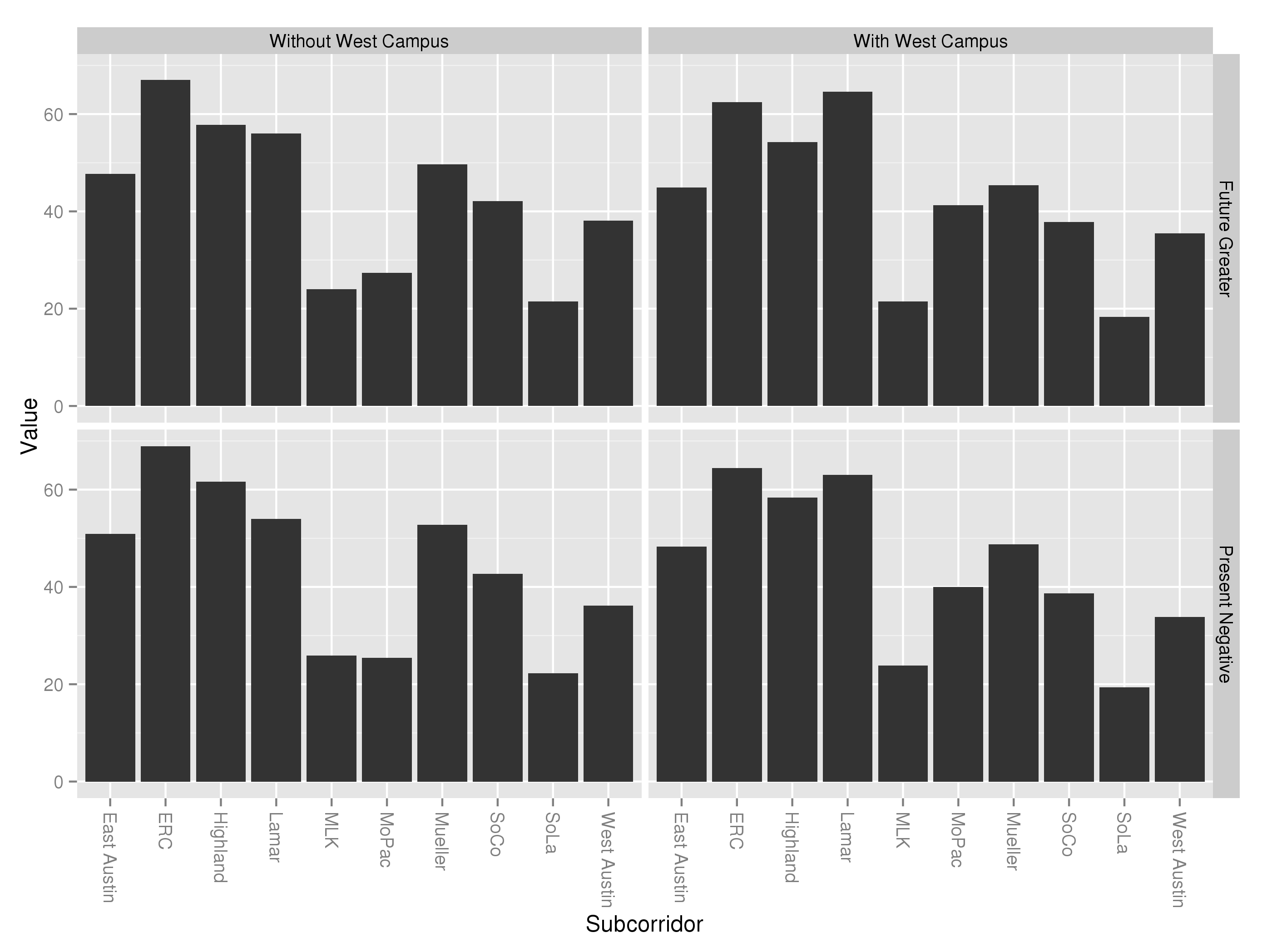In my first glance, I showed that the Project Connect weightings resulted in different recommended subcorridors depending on whether you included West Campus in MoPac and Lamar, and whether you used negative weightings for present-day or used positive weightings for present-day, even if those weightings are smaller than those you use for the future.
I have now put together a superior illustration for this effect here:
As you can see, the choice to negatively weight present-day scores had a dramatic effect on the data excluding West Campus, pushing Highland and Lamar from a virtual tie (upper left) to Highland higher-rated (bottom left). This is not surprising, as Project Connect’s methodology shows Highland as targeted for nearly 3.6% annual growth in population density.
When West Campus is factored into the mix, the effect continues. However, this time the effect of the negative present-day weightings was smaller. With a more balanced weighting (upper right), Lamar is the clear winner and Riverside second. With the negative weightings, Lamar is second to Riverside’s first. In both cases, Highland places third.
I still believe that Project Connect’s methodology for calculating the final score to be confusing and inferior to the more traditional weightings I employed here; one of the reasons for this is that their complications makes effects like these extraordinarily hard to understand at an intuitive level. However, it is noteworthy that their data and methodology draw the same conclusions that mine did (Lamar and Riverside the top two subcorridors) when you include West Campus, and that it ranks Highland and Lamar as equal even excluding West Campus, if you just correct for the negative weightings of present-day data.

This seems to confirm what I have suspected all along, that the exclusion of West Campus from Lamar combined with the over-weighting of future growth were both implemented to insure that Highland/Mueller is the chosen sub-corridor.
I also suspect that the real driver behind all of this is the desire to have rail on Red River by the new UT Medical School and up San Jacinto through campus. I actually don’t think UT cares about rail one bit, so if it doesn’t get its way on where it goes it will refuse to play ball at all, and the Powers That Be are deathly afraid of that. As such, I believe Project Connect is under strict orders to produce an outcome where rail go up Red River/San Jacinto.
I applaud your efforts to bring all of this to light, but I also wonder: if PC will go to such absurd lengths to guarantee a Highland route (and adding WC to the core plus under-weighting current transit ridership are both absurd actions), do we really expect them to act reasonable and go with Lamar now that their shenanigans have been exposed?
I hold out hope that they will, but I just don’t see it happening. If they are willing to rig the game to get their desired outcome, I think they are willing to ignore the screaming few desperately trying to point it out. It would take a massive campaign by the editorial staff of the Statesman and the Chronicle to embarrass them enough to reverse course. Will the Chronicle raise a stink when the new rail line will stop right at their headquarters at Hancock? Perhaps Ben Wear will speak out? It’s possible.
What happens if you include West Campus with Highland?
Would AURA and other neutral advocacy groups support a spur to West Campus or even a main route that goes from West Campus to Red River and north from there?
As I have said before, the assumption that the students of West Campus will only catch rail that stops close to their homes and will avoid rail that stops close to their classes seems flawed. But beyond that, I just don’t see why people continue to assert that West Campus can only be served by a route that continues north on Lamar instead of a route crossing campus on Dean Keeton and then going north on any other street.
> What happens if you include West Campus with Highland?
This is not a question that Project Connect has released data in an easy way to answer. I have only had 7 days to analyze the data that Project Connect has been working with for the last 6 months. That includes data for Lamar + West Campus, and MoPac + West Campus, but not for Highland + West Campus. If you would like to combine the values in the West Campus column and the Highland columns of PC’s spreadsheet, I would run the numbers for you.
Thanks for the clarification, and for all the work on this Dan. These last several posts in particular have been very insightful. Since posting the questions above I have found several links detailing benefits of a straighter line with fewer turns.
Alan, it’s a ridiculous claim for you to make that students would catch rail that goes near their classes. Students in West Campus who ride the rail at all are going to do so to either go to a job or to go somewhere for entertainment. Neither one of which is going to be a common occurrence right after class.
And that’s ignoring the fact that West Campus is also a destination for people from other corridors – i.e. people who specifically choose today to disembark buses on Guadalupe rather than San Jacinto have good reason to do so – why would we expect them to suddenly shift to San Jacinto for rail when they’re not willing to do so today for arguably more reliable buses than those on Guadalupe? It’s because most of the destination traffic in the UT and West Campus zones is on and near Guadalupe and nowhere near San Jacinto (this includes offices for staff members; classrooms for students who maybe live upstream at the Triangle; etc).